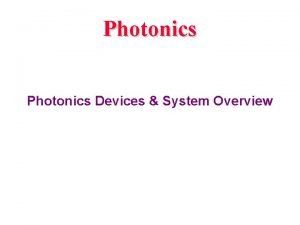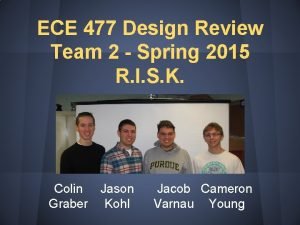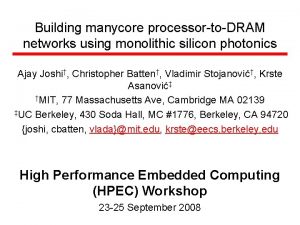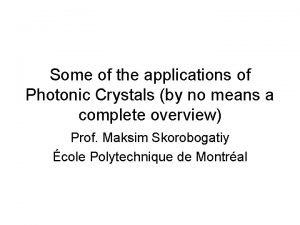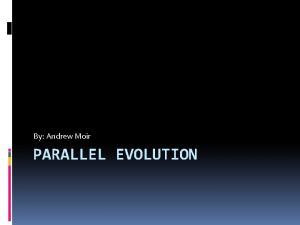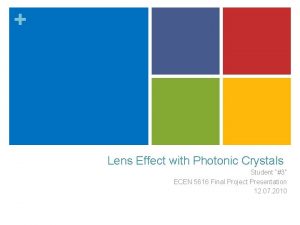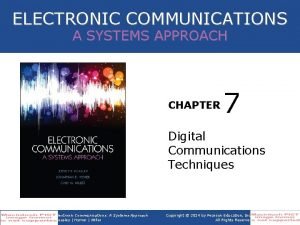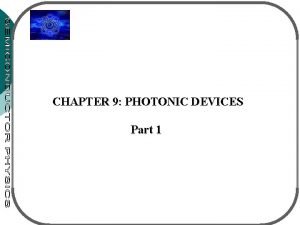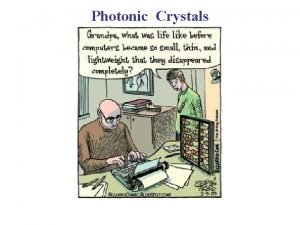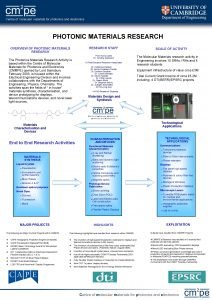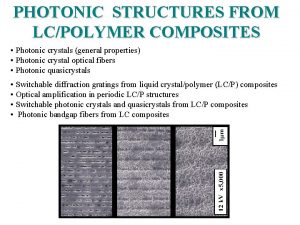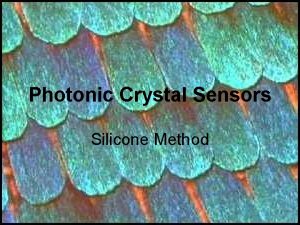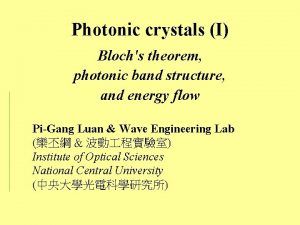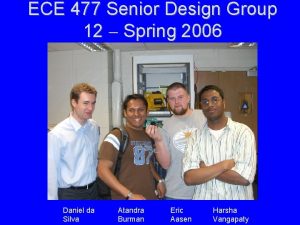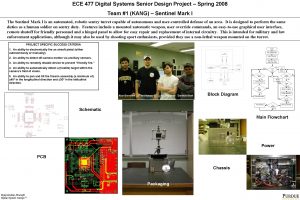ECE 477 Photonic Communications Systems Devices Winter 2006



















- Slides: 19

E&CE 477 Photonic Communications Systems & Devices Winter 2006 Instructor: Hamed Majedi

Content 1 - Overview of Photonic Communications 2 - Optical Fiber: Waveguiding, Propagation Modes - Single Mode Fiber - Fiber Materials & Fabrication Procedures 3 - Signal Degradation in Optical Fibers 4 - Photonic Sources & Transmitters: LED & Laser Diodes - Single Mode Lasers, Modulation & Noise 5 - Laser-Fiber Connections (Power Launching & Coupling) 6 - Photodetectors 7 - Digital Photonic Receivers & Digital Transmission systems 8 - WDM & Photonic Networks

Lab & Computer Simulations • Lab sessions - Fiber Attenuation Measurement - Dispersion Measurement - Spectral Attenuation Measurements • Computer Simulations using Photonic Transmission Design Suite 1. 1 Lite 1 - Bit error rate estimation of digital single channel fiber-optic link 2 - Influence of fiber dispersion on the bit error rate 3 - Fiber dispersion compensation by three different methods 4 - Four channel WDM transmission by four wave mixing 5 - Comparison of external vs. direct laser modulation for various bit rate 6 - Two channel WDM add/drop multiplexer using fiber Bragg gratings & circulators.

Chapter 1 Overview of Photonic Communications

Optics • Optics is an old subject involving the generation, propagation & detection of light. • Three major developments are responsible for rejuvenation of optics & its application in modern technology: 1 - Invention of Laser 2 - Fabrication of low-loss optical Fiber 3 - Development of Semiconductor Optical Device As a result, new disciplines have emerged & new terms describing them have come into use, such as: - Electro-Optics: is generally reserved for optical devices in which electrical effects play a role, such as lasers, electro-optic modulators & switches.

Photonics • Optoelectronics: refers to devices & systems that are essentially electronics but involve lights, such as LED, liquid crystal displays & array photodetectors. • Quantum Electronics: is used in connection with devices & systems that rely on the interaction of light with matter, such as lasers & nonlinear optical devices. • Quantum Optics: Studies quantum & coherence properties of light. • Lightwave Technology: describes systems & devices that are used in optical communication & signal processing. • Photonics: in analogy with electronics, involves the control of photons in free space and matter.

Photonic Communications • Photonics reflects the importance of the photon nature of light. Photonics & electronics clearly overlap since electrons often control the flow of photons & conversely, photons control the flow of electrons. • The scope of Photonics: 1 - Generation of Light (coherent & incoherent) 2 - Transmission of Light (through free space, fibers, imaging systems, waveguides, … ) 3 - Processing of Light Signals (modulation, switching, amplification, frequency conversion, …) 4 - Detection of Light (coherent & incoherent) • Photonic Communications: describes the applications of photonic technology in communication devices & systems, such as transmitters, transmission media, receivers & signal processors.


Why Photonic Communications? • Extremely wide bandwidth: high carrier frequency ( a wavelength of 1552. 5 nm corresponds to a center frequency of 193. 1 THz!) & consequently orders of magnitude increase in available transmission bandwidth & larger information capacity. • Optical Fibers have small size & light weight. • Optical Fibers are immune to electromagnetic interference (high voltage transmission lines, radar systems, power electronic systems, airborne systems, …) • Lack of EMI cross talk between channels • Availability of very low loss Fibers (0. 25 to 0. 3 d. B/km), high performance active & passive photonic components such as tunable lasers, very sensitive photodetectors, couplers, filters, • Low cost systems for data rates in excess of Gbit/s.

BW demands in communication systems Type & applications Format Uncompressed Compressed Voice, digital telegraphy 4 k. Hz voice 64 kbps 16 -32 kbps Audio 16 -24 k. Hz 512 -748 kbps 32 -384 kbps (MPEG, MP 3) Video conferencing 176 144 or 352 2 -35. 6 Mbps 288 frames @ 10 -30 frames/s Data transfer, Ecommerce, Video entertainment 64 kbps-1. 544 Mbps (H. 261 coding) 1 -10 Mbps Full-motion broadcast video 720 480 frames @ 30 frames/s 249 Mbps 2 -6 Mbps (MPEG-2) HDTV 1920 1080 frames@ 30 frames /s 1. 6 Gbps 19 -38 Mbps (MPEG -2)

Early application of fiber optic communication • Digital link consisting of time-division-multiplexing (TDM) of 64 kbps voice channels (early 1980). Optical Fiber communications, 3 rd ed. , G. Keiser, Mc. Graw. Hill, 2000

SONET & SDH Standards • SONET (Synchronous Optical NETwork) is the network standard used in north America & SDH (Synchronous Digital Hierarchy) is used in other parts of the world. These define a synchronous frame structure for sending multiplexed digital traffic over fiber optic trunk lines. • The basic building block of SONET is called STS-1 (Synchronous Transport Signal) with 51. 84 Mbps data rate. Higher-rate SONET signals are obtained by byte-interleaving N STS-1 frames, which are scramble & converted to an Optical Carrier Level N (OC-N) signal. • The basic building block of SDH is called STM-1 (Synchronous Transport Module) with 155. 52 Mbps data rate. Higher-rate SDH signals are achieved by synchronously multiplexing N different STM-1 to form STM-N signal.

SONET & SDH transmission rates SONET level Electrical level Line rate (Mb/s) SDH equivalent OC-1 STS-1 51. 84 - OC-3 STS-3 155. 52 STM-1 OC-12 STS-12 622. 08 STM-4 OC-24 STS-24 1244. 16 STM-8 OC-48 STS-48 2488. 32 STM-16 OC-96 STS-96 4976. 64 STM-32 OC-192 STS-192 9953. 28 STM-64 Optical Fiber communications, 3 rd ed. , G. Keiser, Mc. Graw. Hill, 2000

Evolution of fiber optic systems • • • 1950 s: Imaging applications in medicine & non-destructive testing, lighting 1960 s: Research on lowering the fiber loss for telecom. applications. 1970 s: Development of low loss fibers, semiconductor light sources & photodetectors 1980 s: single mode fibers (OC-3 to OC-48) over repeater sapcings of 40 km. 1990 s: Optical amplifiers (e. g. EDFA), WDM (wavelength division multiplexing) toward dense-WDM. Optical Fiber communications, 3 rd ed. , G. Keiser, Mc. Graw. Hill, 2000

Operating range of 4 key components in the 3 different optical windows Optical Fiber communications, 3 rd ed. , G. Keiser, Mc. Graw. Hill, 2000

Major elements Of typical photonic comm link Optical Fiber communications, 3 rd ed. , G. Keiser, Mc. Graw. Hill, 2000

Installation of Fiber optics Optical Fiber communications, 3 rd ed. , G. Keiser, Mc. Graw. Hill, 2000

WDM Concept Optical Fiber communications, 3 rd ed. , G. Keiser, Mc. Graw. Hill, 2000

Optical Fiber communications, 3 rd ed. , G. Keiser, Mc. Graw. Hill, 2000
 Photonic devices
Photonic devices Ece 477
Ece 477 Ece 477
Ece 477 Ece 477
Ece 477 Ece 477
Ece 477 Tyranny of rocket equation
Tyranny of rocket equation Photonic chip paperclip
Photonic chip paperclip Sopmed training
Sopmed training Photonic bandgap
Photonic bandgap Andy moir photonic
Andy moir photonic Andy moir photonic
Andy moir photonic Finite difference time domain
Finite difference time domain Winter kommt winter kommt flocken fallen nieder
Winter kommt winter kommt flocken fallen nieder Heute mittwoch guten morgen mittwoch winter
Heute mittwoch guten morgen mittwoch winter Was ist deine lieblingsjahreszeit
Was ist deine lieblingsjahreszeit Winter dreams vocabulary
Winter dreams vocabulary Electronic communications a systems approach
Electronic communications a systems approach Telex bosch
Telex bosch Sw 477
Sw 477 Jika log 2 = 0 301
Jika log 2 = 0 301
